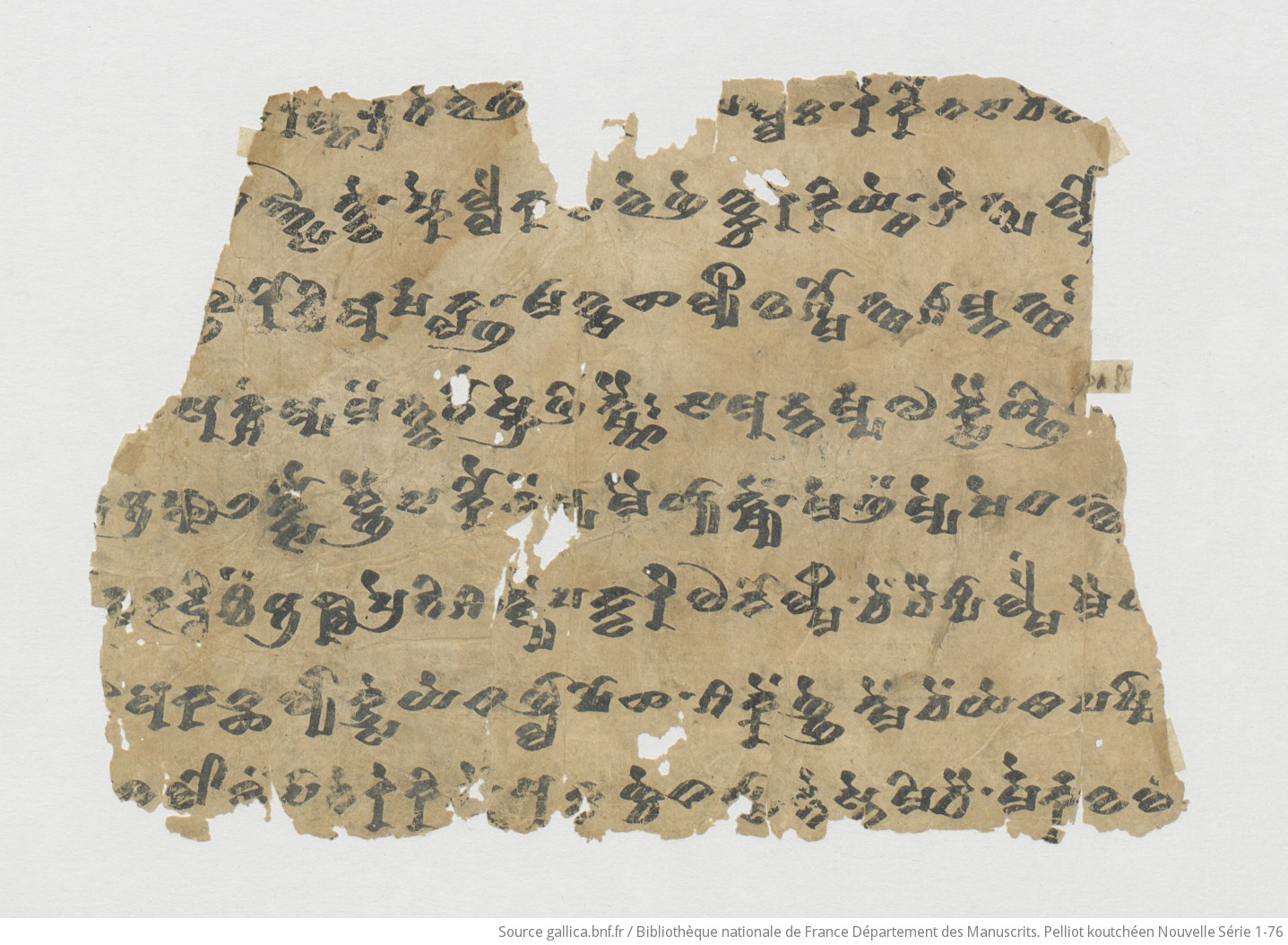| a1 | /// – ra¯ ¯mt• 40 te we ñ[ā] (– – – –) p(·) ll(·) ka • re kau na sa ce – /// |
|---|
| a2 | /// [ta] ṅwsā ntwe • pke lle ka(·) [t]s(·) we ñe wkca re ki ye¯ ¯s • kre ntpa ls[k]o /// |
|---|
| a3 | /// [¯ñ] o ro cci a rṣa kla¯ ¯ñ • mā wsa s̝a lyi ai śmo ntsa śā mna ntsa : /// |
|---|
| a4 | /// su kśaṃ mpa mä ntwa tau skre ñi kṣṇai : sa mu dta rmpa o ksai yñi – /// |
|---|
| a5 | /// – 40 4 la ktsau wñai sa kau nä mpa mai yyā kṣyeṃ • me ñä mpe ṣe ta ṅwa /// |
|---|
| a6 | /// ntra ra ddhi ścä 40 5 pre ti śa nmy[e]ṃ pa kwā ri o no lmi • ceṃ cai śpā lmeṃ mai [y](·)(·) /// |
|---|
| a7 | /// [6] a kā ls̝a lyī kuse ye sa ñlī po s̝a • śa kkeṃ ññe nmeṃ ceṃ ye sa pa ṣṣī /// |
|---|
| a8 | /// wa lo wä rpā te re ki [y]· ·eṃ[¯] [¯ts] ṣu kta ñce ta ssā nte ste mi cai • rme rka wa [lo] /// |
|---|
| b1 | /// yl(·) nta • t(·) ñkr(·) ntau na o ntso ytte lkā skau ṣe¯ ¯k • mā ka rsna tra kre ntau na ścka wo ñ[i] /// |
|---|
| b2 | /// [ṣ]ṣ(·) sa mu dra plye wsa ṣa¯ ¯ñ • nai ntse ypa rwe ta rka rmeṃ swā sa skeṃ • wa rsa ñ[w]e /// |
|---|
| b3 | /// [n]ta lya kā re brā hma ṇi • ā lī sa kṣnai pa rsa tsi we ñe nne • pa rso rsa cai /// |
|---|
| b4 | /// [ṣ](·) kta ñce kau na we¯ ¯s • ce ntsno ña kt(·) ñä śre ki wä rpā mai • ya ma ṣṣa nte pra /// |
|---|
| b5 | /// ta k[ā] n· • [śā] we ra ṣai ke ktse ntsa su wa lo • pū dñä kte ntse pe (·)[e] /// |
|---|
| b6 | /// ne • ñä kte ntsña kte pū dñä kte ka ṣṣi ñi lā maṃ ā ma ñi ā k[s̝a]ṃ /// |
|---|
| b7 | /// b[r]a hmä ce¯ ¯u we ksa ya¯ ¯st [ñ]ä śśau ke ntra ñi ai kne yā mtsi ste 50 [5] /// |
|---|
| b8 | /// ne • k[u](·)e k[s]a ña kti (– – –) (·)ā kṣi kn(·)a 50 6 ā lyau ce [ka] /// |
|---|
| a1 | ... like ... . 40. (I) told that as (the merit) to be (acc)umulated indeed. With words ... this ... |
|---|
| a2 | ... out of love then, I will tell you some word which will mature as a good thing. (With) good spirit ... |
|---|
| a3 | ... big snakes, [with which] wise men should not have company. ... |
|---|
| a4 | ... (43.) [If] crows [are] favorable, being so disposed together with (–)sukśa-birds, they will give me an ox comparable to the ocean. ... |
|---|
| a5 | ... 44. May they teach a force comparable in shining to the sun, [and] a love(ly image?) comparable to the moon. ... |
|---|
| a6 | ... (may) they (reach?) [a stage of] supernatural power. 45. May the evil beings become [lit. go to] Pretas. The excellent ones among them (will become provided with) a force ... |
|---|
| a7 | ... (4)6. The disciples that have been left by you (pl.), may (you [pl.]) protect them from [members] of the Śākyas. ... |
|---|
| a8 | ... 47. ... The king enjoyed the word [of the teacher]. They placed themselves [into] the seventh state (of) the ways [of living] (?). Quickly indeed the king ... |
|---|
| b1 | ... Been unsatisfied I keep looking always at your virtues. My desire towards virtues is not destroyed. ... |
|---|
| b2 | ... The ocean of (happiness?) floated by itself. They make rain for sure the greed at first from the cloud. With new water ... |
|---|
| b3 | ... the Brahmins saw (impuritie)s. [If] they tell to sprinkle it wrongly with the palm [of the hand], by the [mere] sprinkling [of water] these ones [will not purify] ... |
|---|
| b4 | ... [if] you tell (teachings) for one week, I will enjoy the speech, oh lord of these ones. They [the Brahmins] made (wonders?) ... |
|---|
| b5 | ... [it] occurred for him. This king was somewhat big with respect to the body. The dignity of the Buddha lord ... |
|---|
| b6 | ... [If] the Buddha lord, the god of gods, my teacher sits quietly [and] teaches to me (the Law). (54.) ... |
|---|
| b7 | ... with this Brahmic voice [Skt. brahmasvara] they remind me instantly [what] is my duty to do. 55. ... |
|---|
| b8 | ... whichever gods (reach) the aids to enlightenment [Skt. bodhipākṣika-]. 56. ... each other indeed ... |
|---|
| * | In general, this is not an archaic text, but it seems to have been copied from an older manuscript with archaic spellings. This led to the insertion of archaic forms such as the use of word-final -ä and the diphthong ‹ew› and wrong spellings such as arṣaklañ for arṣaklāñ in a3; wsäṣälyi for wsaṣälyi in a3; kärsnaträ for kärsnāträ and kawo for kāwo in b1. In addition, it is conceivable that the original had a different meter or was even a prose text that has been revised by the poet as to fit this new meter. This could explain some strange syntactic constructions, the omission of subordinate conjunctions (pādas 44a, 51c, 54d, 55d) and the pāda-internal use of word-final -ä (note that even in archaic texts o mobile and word-final -ä are usually confined to pāda-final position, and we would not expect so many -ä writings but rather o mobile in the first place. |
|---|
| * | All virāma writings are of the akālk-type: ramt\• (a1); yes\ (a2); arṣaklañ\ (a3); ṣek\ (b1); ṣañ\ (b2); wes\ (b4); yast\ (b7). |
|---|
| * | Note the use of fremdzeichen ‹na› beside ‹nä›. |
|---|
| * | kṣṇai in a4 and =kṣnai in b3 recall Skt. akṣnayā 'diagonally, transversely' and 'wrongly'. In the second instance we have probably a sandhi form akṣnai, i.e. the direct loan of this Sanskrit form. The meaning 'wrongly' also seems to be fitting here. In the first instance, however, a sandhi form with syncope of the a after semivowel would be highly unexpected. In addition, the meaning 'wrongly' seems contradictory with the following statement predicting the gift of immense wealth. Therefore, one may make the hypothesis that kṣnai derives from Sanskrit *kṣṇayā 'straight', which was due to a reanalysis of akṣṇayā as negative derivative. The passage in a4 seems to refer to the Indian tradition of divination using the behavior of birds, esp. corvidae. The second refers to the commonplace custom of purification by water in Brahmanic tradition. |
|---|
| * | The meter is 4 x 10 (4/6). The pāda boundary is often indicated by a single dot instead of double dot. |
|---|
| * | Missing syllables at the end of each line: |
|---|
| * | (–)sukśaṃmpa is the comitative plural of a noun of the type kroṅśe 'bee' and maybe refers to a bird. |
|---|
| n1 | The damaged sign at the end of the line is either ‹wa›, ‹la›, or ‹o›. |
|---|
| n2 | = 20 syllables each; a4 = 19 syllables; a5 = 14 syllables; a6a7 = 20 syllables each; a8 = 18 syllables; b1b2 = 20 syllables each; b3b4 = 10 syllables each; b5 = 19 syllables; b6 = 20 syllables; b7 = 19 syllables. |
|---|
| n3 | The damaged sign at the beginning of the line is maybe [kṣ](·). |
|---|
| n4 | The damaged sign at the beginning of pāda 47a is probably a gen.pl. in -eṃ[ts\]. Before we have a large ligatura that can be a reduced form of yakne based on the archaic form yäkne. The same kind of incorrect syncope at the beginning of a pāda recurs in the next line with rmer for ramer. |
|---|
| n5 | The segmenation of yl(·)nta is uncertain. We can have a plural in -nta or the particle nta. |
|---|




